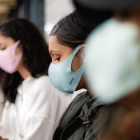
OSHA Rules for Eye and Face Protection Have Been Updated
 New OSHA rules for eye and face protection were published in the US Federal Register on March 25, 2016. Affected companies–which include all employers operating in general industry, shipyards, longshoring, marine terminals, and construction–should reference the full text of the Federal Register as well as the updated consensus standard which has been incorporated by reference, ANSI/ISEA Z87.1-2010 – Occupational and Educational Personal Eye and Face Protection Devices.
New OSHA rules for eye and face protection were published in the US Federal Register on March 25, 2016. Affected companies–which include all employers operating in general industry, shipyards, longshoring, marine terminals, and construction–should reference the full text of the Federal Register as well as the updated consensus standard which has been incorporated by reference, ANSI/ISEA Z87.1-2010 – Occupational and Educational Personal Eye and Face Protection Devices.
Changes are summarized in a media release from MSA Safety (Doc. ID: 0300-05-MC, April 2010). Noteworthy excerpts with underlined formatting for emphasis:
- Users will need to be educated on matching the hazard from which they need protection with the marking on the product.The Z87 ASC also made efforts to harmonize with other eye and face protection standards used around the world. Many of the tables in this standard reflect this effort to harmonize with global standards.
- Extended side protection. Spectacles with thin temples (metal frame or thin plastic) will require side shields if they do not pass the extended side coverage requirements.
- In Z87.1-2003 protective products are marked as providing “Basic” or “High Impact” protection. In the Z87.1-2010 standard, the products are either non-impact or impact protectors. Products marked as impact protectors must pass all high-impact testing requirements and will be marked as “Z87+”. Non-impact protectors are those which do not pass all high-impact testing requirements and are therefore marked only with “Z87” (no “+” sign).
- In the Z87.1-2003 standard, protective products are defined as primary and secondary protectors; primary eye protection should be used under secondary protection (i.e., safety glasses must be worn under visors). This is changing in the Z87.1-2010 standard.
Manufacturers adhering to ANSI/ISEA Z87.1 will be keeping pace with new testing and marking specifications. That said, it takes time to deplete existing inventory, test, adapt, manufacture and distribute new models. Changes are gradual and that is precisely why OSHA is adopting the 2010 standard now, in 2016.
Companies can continue to distribute and use PPE determined by hazard assessment to adequately protect against site and task-specific hazards – even if it is marked according to the specifications of previous 1989 and 2003 versions of the ANSI standard.
As the useful service life of existing PPE requires replacement, companies should ask distributors to provide eye and face protection that bears the newly required markings. But first companies need to reassess and revise eye and face PPE recommendations with increased type, use, shade and filter specificity in mind.
OSHA “direct final rule” cadence incorporating industry requirements from prior years suggests future changes as the consensus evolves. Companies would do well now to consider the newer 2015 version of ANSI/ISEA Z87.1 while referencing the recently incorporated 2010 version.




